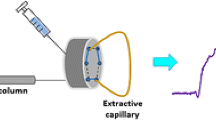Abstract
This article describes an on-line technique for hydrodynamic injections of long sample plugs with simultaneous stacking of iodine species in capillary electrophoresis (CE) with diode array detection. Surfactant-coated multi-walled carbon nanotubes (SC-MWNTs) were used as a pseudostationary phase for the separation of iodate, tetraiodothyronine,triiodothyronine, diiodothyronine, and diiodotyrosine. The effects of MWNTs, concentration of SC-MWNTs and salt, of buffer pH value, injection times were examined. Under the optimized conditions, i.e. detection at 230 nm, a separation voltage 25 kV, a borate running buffer of pH 7.5 and a SC-MWNT concentration of 9 μg · mL−1, the method gave relative standard deviations of the retention times and peak areas in intra-day assays (for n = 6) and for inter-day assays (for n = 3) of less than 4.49 and 5.80 %, respectively. The CE method was then applied to the analysis of the above iodine species in (spiked) kelp (kunbu) and porphyra, and recoveries ranged from 81.6 to 98.4 % with RSDs (n = 3) for extraction repeatability of <3.39 % in all cases.

Surfactant coated multi-walled carbon nanotubes were used as a pseudostationary phase to improve separation in iodine speciation. A highly sensitive stacking method was developed to enhance the detection sensitivity of iodine species. The CE method was then applied to the analysis of iodine species in kelp and porphyra.



Similar content being viewed by others
References
Iijima S (1991) Helical microtubules of graphitic carbon. Nature 354:56–78
Cao J, Li P, Yi L (2011) Ionic liquids coated multi-walled carbon nanotubes as a novel pseudostationary phase in electrokinetic chromatography. J Chromatogr A 1218:9428–9434
Herrero-Latorre C, Barciela-García J, García-Martín S, Pena-Crecente RM, Otárola-Jiménez J (2015) Magnetic solid-phase extraction using carbon nanotubes as sorbents: a review. Anal Chim Acta 892:10–26
Cao J, Dun WL, Qu HB (2011) Evaluation of the addition of various surfactant-suspended carbon nanotubes in MEEKC with an in situ-synthesized surfactant system. Electrophoresis 32:408–413
Moliner-Martínez Y, Cárdenas S, Valcárcel M (2007) Evaluation of carbon nanostructures as chiral selectors for direct enantiomeric separation of ephedrines by EKC. Electrophoresis 28:2573–2579
López-Pastor M, Domínguez-Vidal A, Ayora-Cañada MJ, Simonet BM, Lendl B, Valcárcel M (2008) Separation of single-walled carbon nanotubes by use of ionic liquid-aided capillary electrophoresis. Anal Chem 80:2672–2679
Li QL, Yuan DX (2003) Evaluation of multi-walled carbon nanotubes as gas chromatographic column packing. J Chromatogr A 1003:203–209
Moreda-Piñeiro A, Romarís-Hortas V, Bermejo-Barrera P (2011) A review on iodine speciation for environmental, biological and nutrition fields. J Anal Atom Spectrom 26:2097–2308
Huang Z, Ito K, Timerbaev AR, Hirokawa T (2004) Speciation studies by capillary electrophoresis –simultaneous determination of iodide and iodate in seawater. Anal Bioanal Chem 378:1836–1841
Chen ZL, Megharaj M, Naidu R (2007) Speciation of iodate and iodide in seawater by non-suppressed ion chromatography with inductively coupled plasma mass spectrometry. Talanta 72:1842–1846
Chen JH, Wang KE, Jiang SJ (2007) Determination of iodine and bromine compounds in foodstuffs by CE-inductively coupled plasma MS. Electrophoresis 28:4227–4232
Han X, Cao LH, Cheng HY, Liu JH, Xu ZG (2012) Determination of iodine species in seaweed and seawater samples using ion-pair reversed phase high performance liquid chromatography coupled with inductively coupled plasma mass spectrometry. Anal Methods 4:3471–3477
Sun JN, Wang D, Cheng HY, Liu JH, Wang YC, Xu ZG (2015) Use of ion-pairing reagent for improving iodine speciation analysis in seaweed by pressure-driven capillary electrophoresis and ultraviolet detection. J Chromatogr A 1379:112–117
Quirino JP, Terabe S (1999) Sample stacking of fast-moving anions in capillary zone electrophoresis with pH-suppressed electroosmotic flow. J Chromatogr A 850:339–344
El-Awady M, Pyell U (2014) Processes involved in sweeping as sample enrichment method in cyclodextrin-modified micellar electrokinetic chromatography of hydrophobic basic analytes. Electrophoresis 35:605–616
Bai Y, Chang CL, Du FY, Tan ZJ, Bai Y, Liu HW (2014) Combination of dynamic pH junction with capillary electrophoresis-mass spectrometry for the determination of systemins in plant samples. Electrophoresis 35:1984–1988
Malá Z, Gebauer P, Boček P (2011) Contemporary sample stacking in analytical electrophoresis. Electrophoresis 32:116–126
Suárez B, Simonet BM, Cárdenas S, Valcárcel M (2007) Surfactant-coated single-walled carbon nanotubes as a novel pseudostationary phase in capillary EKC. Electrophoresis 28:1714–1722
Romarís-Hortasa V, Bermejo-Barreraa P, Moreda-Piñeirob J, Moreda-Piñeiro A (2012) Speciation of the bio-available iodine and bromine forms in edible seaweed by high performance liquid chromatography hyphenated with inductively coupled plasma-mass spectrometry. Anal Chim Acta 745:24–32
Acknowledgments
This study was supported by the National Natural Science Foundation of China (No. 81274065), the Zhejiang Provincial Natural Science Foundation of China (LY15H280016), the Hangzhou social development of scientific research projects (No. 20150533B05), Research on Public Welfare Technology Application Projects of Zhejiang Province (No. 2014C37069), Young and Middle-Aged Academic Leaders of Hangzhou (2013–45), and Changjiang Scholars and Innovative Research Team in Chinese University (IRT 1231).
Author information
Authors and Affiliations
Corresponding authors
Ethics declarations
The author(s) declare that they have no competing interests.
Electronic supplementary material
Below is the link to the electronic supplementary material.
ESM 1
(DOCX 910 kb)
Rights and permissions
About this article
Cite this article
Xu, JJ., Chang, Yx., Hao, J. et al. Separation and stacking of iodine species from seafood using surfactant-coated multiwalled carbon nanotubes as a pseudo-stationary phase in capillary electrophoresis. Microchim Acta 183, 2441–2447 (2016). https://doi.org/10.1007/s00604-016-1892-6
Received:
Accepted:
Published:
Issue Date:
DOI: https://doi.org/10.1007/s00604-016-1892-6




